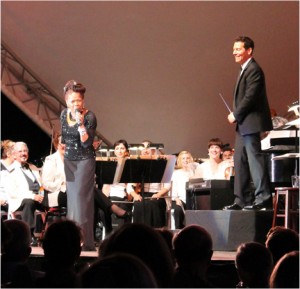By Robert D. Thomas
Music Critic
Pasadena Star-News/San Gabriel Valley Tribune/Whittier Daily News
A shorter version of his article was first published today in the above papers.
With summer seasons for the most part in our rear-view mirror, three major arts organizations will open their 2013-2014 classical music seasons next weekend.
• The Los Angeles Chamber Orchestra begins its 45th season Saturday night at 8 in Pasadena’s Ambassador Auditorium and next Sunday at 7 p.m. in UCLA’s Royce Hall. Preconcert lectures will take place an hour before each performance.
The program will feature 24-year-old violinist Benjamin Beilman as soloist in Mozart’s “Turkish” Violin Concerto. Jeffrey Kahane, beginning his 17th season as LACO’s music director, will also lead the orchestra in music by Beethoven, Kodaly and Lutoslawski. INFO: 213/622-7001; www.laco.org
Due to a renovation of Glendale’s Alex Theatre, this will be the first of two LACO orchestra series concerts that will be held at Ambassador, which LACO called home during the 1980s and 1990s. The orchestra will also play its annual “Discover Beethoven” concert at Ambassador on Feb. 22, 2014.
• Los Angeles Opera opens its 28th season Saturday night at 7:30 p.m. in the Dorothy Chandler Pavilion with the first of seven performances of Bizet’s Carmen. Other performances are Sept. 26 and 28 and Oct. 1 and 4 at 7:30 p.m. and Sept. 29 and Oct. 6 at 2 p.m.
Irish mezzo-soprano Patricia Bardon will perform the title role in all but one of the performances (Belgrade-born Milena Kitic appears on Sept. 28). The opening-night cast includes José Brandon Jovanovich as Don Jose, Ildebrando D’Arcangelo as Escamillo, and Pretty Yende in her company debut as Micáela. Some performances intersperse other singers so check carefully before you decide on when to attend.
Plácido Domingo, the company’s general director, will conduct four of the performances, including opening night, while Grant Gershon, LAO’s resident conductor will lead the other three. The production originated at Teatro Real in Madrid and has previously been used by LAO in 2004 and 2009. Opening night will be broadcast live on KUSC (91.5-FM). INFO: 213/972-8001; www.laopera.com
LA Opera has announced that it will present three semi-staged productions of André Previn’s opera, A Streetcar Named Desire, May 18, 21 and 24 in the Pavilion. Soprano Renée Flemming will sing the title role; she will be joined by some members of the cast that performed during the work’s debut in San Francisco in 1998. Patrick Summers, now principal conductor at San Francisco Opera, will conduct the three performances here. INFO
Previn, now 84, first made his name composing and arranging in Hollywood, winning Academy Awards in 1958 for scoring Gigi and 1959 for Porgy and Bess and then winning in 1963 for adapting Irma La Douce and 1964 for My Fair Lady. He has also written hundreds of classical and jazz compositions and other works. A Streetcar Named Desire ,based on Tennessee Williams’ Pulitzer-Prize winning play from 1947, was Previn’s first opera (he also wrote Brief Encounters in 2007).
Previn eventually scratched a long-standing itch when he turned to conducting orchestras, including the Houston Symphony and Pittsburgh Symphony. In 1985, he succeeded Carlo Maria Giulini as music director of the Los Angeles Philharmonic, a position he held until 1989. He also worked extensively with the London Symphony Orchestra and made a number of recordings with the LSO. Although Previn has rarely conducted in Los Angeles since his acrimonious departure as LAPO music director, one could only hope that the Phil would find a way to have him conduct during the May opera cycle, perhaps a concert of his own music.
The semi-staged production of A Streetcar Named Desire played earlier this year at Carnegie Hall and Lyric Opera of Chicago. LAO has an interesting article with Previn and Flemming commenting on the work on its Web site HERE.
A Streetcar Named Desire becomes the third 20th century opera that LAO will present this season. Einstein on the Beach, a landmark 1976 collaboration between director Robert Wilson and composer Philip Glass, will play Oct. 11, 12 and 13 in the Pavilion. INFO
Benjamin Britten’s Billy Budd will be presented six times, beginning Feb. 22, 2014. INFO Billy Budd is LAO’s major offering in the celebration of the centennial of Britten’s birth (he was born Nov. 22, 1913).
• Los Angeles Master Chorale opens its 50th anniversary season and its 10th as a resident ensemble at Walt Disney Concert Hall next Sunday at 7 p.m. when Grant Gershon leads 115 singers in an eclectic program featuring highlights from the Chorale’s four music directors during its first half-century: Roger Wagner (1964-1986), John Currie (1986-1991), Paul Salamunovich (1991-2001) and Gershon, who took over in 2001. The finale will be a performance of Randall Thompson’s a cappella anthem Alleluia performed by current and former LAMC members. INFO: 213/972-7282; www.lamc.org
_______________________
(c) Copyright 2013, Robert D. Thomas. All rights reserved. Portions may be quoted with attribution.

